2019 年 7 巻 p. 29-40
2019 年 7 巻 p. 29-40
Potato (Solanum tuberosum), is the most consumed vegetable in Bangladesh throughout the year round. Due to the suitable environment, potato production is increased day by day and in 2019 Bangladesh became the seventh largest potato producing country in the world. Now the amount of production is more than the demand and hence from recent few years Bangladesh starts to exports potato and its associated food products to the different countries in the world. Unemployment problem is very common in the developing countries like Bangladesh but potato gives an opportunity to solve the problem and also help to eradicate the situation of hunger. Though bumper harvest of potato is very common in Bangladesh but the growers are sometimes devoid of to get the fair price due to the extreme margin by the middlemen. Hence, the aim of this study is to examine the present situation of potato production, storage, marketing system, and export. The major findings of this study are as follows: Firstly, poor transportation system, inadequate storage facilities, lack of capital, lack of knowledge of farmers about market price, illiteracy, and syndicate system of middlemen are some key factors for inefficient marketing system of potato in Bangladesh. Secondly, giving the increased important in potato is not the ultimate solution, instantly improve the marketing mechanism of potato is required for Bangladesh. Finally, it is exigent that government needs to take the obligatory steps for the sustainable production and marketing system of potato in Bangladesh.
In Bangladesh more than 100 vegetables are produced (Rubayet and Jony, 2016). Among a huge variety of vegetables, potato stands first by choice of farmers after introducing some preservation facilities like cold storage and so on (Moazzem and Fujita, 2004). Whole year round demand of potato by consumers and the high perishable rate of other vegetables due to lack of preservation facilities are also responsible for the higher production within last few years though the cultivation of potato was started at late 19th century in Bangladesh (Baset et al., 2009) in contrast to 17th century in Indian sub-continent (Pandey et al., 2000) and commercial production of crops was started from 1920 (Hossain et al., 2008). The geographical suitability of Bangladesh is also responsible for the increase production of potato in every year (Nunn and Qian, 2011). Generally lower-income people consume more potatoes rather than other vegetables (Pitt, 1983; McCracken and Marotz, 1989) and as a whole the potato consumption stands third position among other cereal crops, just after rice and wheat (Thomson and Kelly, 1957). On the other hand, the government of Bangladesh wants to promote to eat potato instate of rice, to reduce continuous pressure on rice (Chowdhury and Chowdhury, 2015). In winter season when the supply of potato is abundant, rural households of Bangladesh used it as a partial substitute of rice (Scott and Suarez, 2011). As a result the cultivation of potato is increasing day by day in Bangladesh. According to Department of Agriculture Extension (DAE, 2016) of Bangladesh, 8.95 million metric tons potato was produced in the fiscal year (FY) 2013-2014 which was 0.345 million metric tons higher than the previous FY. For this tremendous production, now Bangladesh is the seventh largest potato producer’s country in the world followed by the production of China, India, Russian Federation, Ukraine, United States, and Germany and third in Asia (FAOSTAT, 2019). The increased cultivable land along with the increased per hectare yield were helped to achieved this remarkable production (BBS, 2016).
Thus potato consumed as vegetable in Bangladesh rather than staple food in other first world country (Hong et al., 2017) and in relation to per capita consumption Bangladesh stands second by consuming 23 Kilograms (Kg) after China, where the consumable amount was 32 Kg (Reardon et al., 2012); but as a most used vegetable, potato consumed over 100 countries of the world (Hajong et al., 2014). From the nutritional aspect, potato is one of the cheapest sources of carbohydrates and furnishes appreciable amount of vitamin B6 (Pyridoxine) and C as well as some minerals (King and Slavin, 2013). Potato provides twice as much as calories per unit area of land and in a shorter period of time compared to rich and wheat (Guenthner, 2010). There are lots of palatable foods made from potatoes. Some processed food from potato are now available in the market of the Bangladesh, like chips, crackers, crisps, French-fries and starch but it is negligible in compared to developed country, where 10 percent of their production is converted to processed food and 4 percent is processed for starch (Keijbets, 2008). In addition, some processing industries such as production of alcohol, glucose, dextrin and citric acid for textile and paper industries, inks, dyes, soap and leather industries use potato as their raw materials (Abouzied and Reddy, 1986). Potato is also used for the production of bio-ethanol (Azad et al., 2014). Uses of potato and other agricultural product were also described in different paper (e.g. Fadel, 2000; Yamada et al., 2009; Izmirlioglu and Demirci, 2012; Mukul et al., 2013; Hossain and Abdulla, 2015; Hossain and Abdulla, 2016 and Hossain et al., 2016; Pacifico and Paris, 2016). So the continuous increased demand insists to produce huge amount of potatoes. In addition, potato is a high productivity crops (Azimuddin et al., 2009) and helpful to eradicate hunger from Bangladesh to achieved Millennium Development Goals within 2015 (Hossain and Abdullah, 2016).
Though this huge production, the farmers were devoid of a good margin from their cultivated product. Maximum growers sell their product immediate after harvesting due to small amount of storage facilities, ignorance about market price and cash need (Hajong et al., 2014). Basically this distressed sale occurred during pick production season at March to April (BIDA, 2016). Along with this, some other risk factors such as consumers taste and priorities, weather instability, storing infestation of diseases and so on helps to change the market situation rapidly (Hall et al., 2006) which also triggered farmers to sell their product immediate after harvest. Middlemen are waiting for this situation and buy potatoes from farmers and stored, then sold them in high pricing month of October to December (BIDA, 2016). Due to the interrupted supply of the electricity, temperature of the cold storage can`t be maintain properly; as a result shrinking, sporulation and some potato became rotten, which reduce the weight of the potato (Hajong et al., 2014). Sometimes it becomes less than 70 percent of its original size (Walker et al., 1999). About 2-9 percent of cold stored potato affected by diseases (Khan et al., 1973) which is equal to 80 million Bangladeshi currency/ taka (BDT) (Azimuddin et al., 2009). These diseases occur in the cold storage due to over density because freeness of the diseases of potato depends directly proportional to its preservation space (Scott and Suarez, 2011, 2012). By this way, about one third of annual production of potato waste every year which hamper our economy badly (Chakraborty and Roy, 2016) otherwise sharing of GDP from agricultural products will increase. Due to the above said circumstances, the terminal consumers need to pay more money for buying the product but farmers share on this wages is very low. This sort of inefficient marketing system doesn`t assure a remunerative prices to the farmers. This type of problems presents most of the developing countries due to presence of excessive number of intermediaries between producer and consumer (Huq et al., 2004) but their role in marketing can’t be demoralized (De and Bhukta, 1994). So it is very important to find out the alternative ways to benefit the farmers and also not to squeeze the income opportunity of other persons like intermediaries. Hence, the aim of this study is to analyze the present situation of potato production, storage, marketing system and export with its constraints which become acquainted with some previous efficient works.
The socio-economic status of farmer’s influences the production of potato (Mukul et al., 2013). This status includes age, educational quality, farm size, farming experience, ability of understands for choice of variety of potato according to the soil quality and so on of farmers. Basically, major portion of farmers are illiterate and young. Among potato cultivating farmers, 53.3% were illiterate, average age in between 20-35 years, and working experience in between 1-10 years (Mukul et al., 2013). Notable thing was no higher educated people in Bangladesh were directly involved in the cultivation of potato. Generally potato cultivating farmers can be grouped in to 4 groups- landless (0 acres), small farm size (0.01-0.49 acres), medium farm size (0.50-1.49 acres) and large farm size (≥1.50 acres) (Moazzem and Fujita, 2004). They found that 25% farmers were landless but they cultivate other land that’s why they known as borgachasi. Landless and small farm sized farmers generally collect money as loan from other rich person or from some organization like as bank to cultivate potato. But for the landless farmers it is difficult to loan money from bank as a result they borrow money from other rich person with a high interest. They have to return the borrowed money immediate after harvesting their cultivated crops. That’s why farmers need cash and they sold their product in low price during the harvesting period. As a whole by cultivating potato they are not benefited properly.
Two varieties of potato were cultivated in Bangladesh- high yielding varieties and local varieties (Uddin et al. 2010). Among high yielding variety, major types were Diamant, Cardinal, Granola, Multa, Patrones, Origo, Binella, Heera, Asterix, Elvira, Ultra, Provento, Kufrisinduri and so on, on the other hand, Shilbilati, Indurkani, Lal pakri, Pakri, Surjamukhi were major types of local variety potato. Among these two types of varieties, farmers of Bangladesh try to cultivate high yielding variety because the quality seeds are not available and also prone to infected by pest and different types of diseases of local varieties. Among different types of high yielding variety, farmers prefer to cultivate Granola because its production rate was more than other types (Uddin et al. 2010).
The ideal potato growing temperature is 45° to 80°F and in Bangladesh potato mainly cultivate in winter season when the temperature stands in between 64° to 84°F (Haverkort, 1990; Khurana and Garg, 2003). Severe damage of potato may occur when temperature drops below 32°F (Hijmans, 2003). So, for the suitable environment, every year Bangladesh produced and consumed large quantities of potatoes (Hossain and Abdulla, 2016). In production and consume perspective, potato is the third and second largest food crops in Bangladesh, respectively (FAOSTAT, 2014). Using of potato as processed and fresh food forms are increasing day by day in Asian countries as well as in Bangladesh (Brown, 2005) for its nutritional impact. Potato contains 75-80% water, 16-20% carbohydrates, 2.5-3.2% crude protein, 1.2-2.2 true protein, 0.8-1.2% minerals, 0.1-0.2% crude fats, 0.6% crude fiber and some vitamins (Schoenemann, 1977). The increasing trend of potato production is also triggered by continuous demand of processing industries (Iritani, 1981). Now a day, Bangladesh exports some portion of its produced potato and potato oriented food to other countries. So, good variety of potato is very much essential to maintain the quality in exports and also in processing industries which will ensure the good price (Connor, 2001). Generally, in every FY, potato cultivated area increased consequently in Bangladesh (BBS, 2016; FAOSTAT, 2019). Table 1 showed the total harvested potato area in contrast to total harvested cropped area during FY 2000-01 to 2014-15. Harvesting pattern of potato also showed in Table 1. Potato cultivating land increased rapidly in comparison with total cropped area in those FY with a little exception in FY 2001-02, 2006-07, 2008-09, and 2011-12 due to the natural calamities. These data strongly suggest that potato production and cultivation is increased in day by day due to the increased demand.
| Fiscal Year (FY) | Total harvested cropped area (hectors) |
Total harvested potato area (hectors) |
Increasing potato harvesting area (%) |
|---|---|---|---|
| 2000-01 | 707217 | 248988 | -- |
| 2001-02 | 687790 | 237600 | -4.57 |
| 2002-03 | 693734 | 245318 | 3.25 |
| 2003-04 | 703761 | 270740 | 10.36 |
| 2004-05 | 846999 | 326291 | 20.52 |
| 2005-06 | 890723 | 373200 | 14.38 |
| 2006-07 | 864752 | 345000 | -7.55 |
| 2007-08 | 875914 | 402000 | 16.52 |
| 2008-09 | 876316 | 395000 | -1.74 |
| 2009-10 | 920483 | 435000 | 10.13 |
| 2010-11 | 975186 | 460197 | 5.79 |
| 2011-12 | 980237 | 430446 | -6.47 |
| 2012-13 | 920379 | 443934 | 3.13 |
| 2013-14 | 946158 | 461710 | 4.00 |
| 2014-15 | 984174 | 471013 | 2.01 |
In consideration of production, potato is one of the most promising crops in Bangladesh. Along with the increasing potato cultivated area, production was also increased. In every fiscal year department of agricultural extension, Bangladesh fixed the production targets of every cultivated crop. Most of the times, the actual production of the potato is higher than the target production. Decreased intensity of the natural calamity like as flood, supply of high quality seed, fertilizer, pesticide and proper facility of management provided by the agricultural officers are helpful to achieve the over production during the last couple of years. Table 2 showed the information about actual production and production pattern of potato in every FY from 2000-01 to 2014-15. The department of agricultural extension, Bangladesh, fixed the production target of potato in every FY but generally the actual production becomes higher than the target (DAE, 2016). Except some exception, actual production of potato increased in every FY with a high increase in FY 2009-10. Previously we discussed that the continuous increased demand of potato is initiating the farmers to produce more amount of potato. Along with the increasing cultivated land for potato, the production was also increased. The productive curve was dramatically increased from the beginning of 21st century with a bit variation (Fig. 1).
| Fiscal Year (FY) | Actual production (tonnes) | Production increased (%) |
|---|---|---|
| 2000-01 | 3216000 | -- |
| 2001-02 | 2994000 | -6.90 |
| 2002-03 | 3385910 | 13.09 |
| 2003-04 | 3907120 | 15.39 |
| 2004-05 | 4855377 | 24.27 |
| 2005-06 | 5368400 | 10.57 |
| 2006-07 | 5167000 | -3.75 |
| 2007-08 | 6648000 | 28.66 |
| 2008-09 | 5268000 | -20.76 |
| 2009-10 | 7930000 | 50.53 |
| 2010-11 | 8326389 | 4.99 |
| 2011-12 | 8205470 | -1.45 |
| 2012-13 | 8603000 | 4.84 |
| 2013-14 | 8950000 | 4.03 |
| 2014-15 | 9254285 | 3.39 |
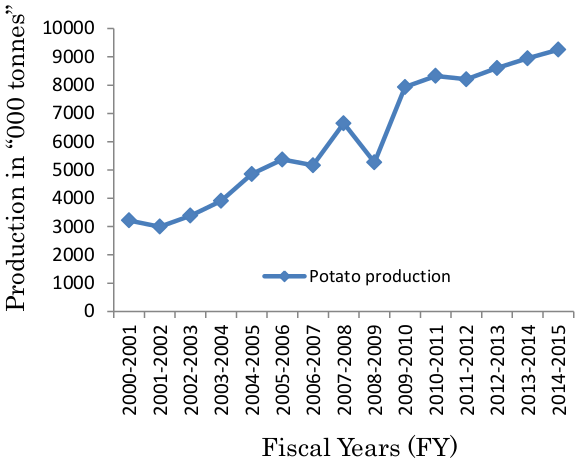
Increased production tendency of potato during FY 2000-2001 to 2014-2015. Source: BBS, 2016; FAOSTAT, 2019.
The purpose of potato storage is to maintain their most edible and marketable condition and also to provide a uniform flow of potato to market and processing plants throughout the year (Eltawil et al., 2006). But it must be realized that some damage can be happened even if the optimum storage facility is provided. Temperature, humidity, CO2 and air movement are the most important factors during storage (Harbenburg et al., 1986) and potato have a tendency to high storage loss during first three months of storage (Varns et al., 1985). However, before storing, the storability of potatoes should be determined by such factors like- cultivar, growing techniques, type of soil, weather conditions during growth, diseases before harvesting, and maturity of potatoes at the time of harvesting, damage to tubers during lifting, transport and filling of the store (Rastovesky, 1987; Burton et al., 1992).
In Bangladesh, different methods of potato storing are used. Some small scale farmers of northern Bangladesh use traditional method but it is not well established method for preservation of potato in Bangladesh. In southern part of Bangladesh, some innovative storage system is used, namely- ambient type potato storage and coolbot storage by the help of The United States Agency for International Development (USAID), International Potato Center (CIP), World Vegetable Center (AVRDC), Bangladesh Agricultural Research Institute (BARI) and some Non-Government organization (NGO) - BRAC and PROSHIKA. But most popular and new storing system is cold storage. According to DAM, 2016; out of 375 cold storages, 343 are now active and provide their service for storing potato. In 2014, 346 cold storages were providing their service but in 2015, 3 cold storages were out of their service.
In 2014, the available storing capacity was 2617948 tonnes but only 1998631 tonnes was stored. On the other hand the storing capacity was decreased to 2598948 in 2015 and the storing volume was increased to 2022135 tonnes (Fig. 2). Proper management, relatively low fare and the non-stopping electricity supply can enhance the storing volume of cold storage. The cold storage owners are busy with their storing business but previously they were engaged with trading and contract framing with farmers also (Lewis, 1991). In recent few years Bangladeshi farmers and potato marketing associated peoples become habituated with this new technology of preservation in cold storage. Therefore, we cannot manage data before FY 2013-14. So, it will be interesting enough if future research will go by this way- efficacy of cold storage in potato preservation in Bangladesh.
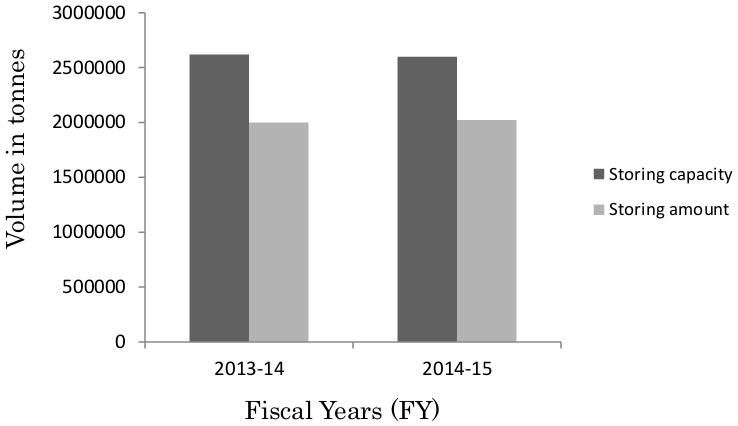
Preservation scenario of potato in cold storage during two succeeding FY. Source: DAM, 2016.
A large number of intermediaries are associated with the marketing channel of potato. All intermediaries are essential for the proper supply of potato because they collect the segregated production and distribute throughout the country. In a developing country like Bangladesh where the unemployment problem is available, long potato marketing gives the opportunity to work some people easily. Their specific function was described previously by some researchers (e.g. Das and Hanaoka 2014) and briefly as follows-
Faria: Faria is a pretty trader who handled small volume of product and purchases potato from the farmers. After that sells it to bepari. Sometimes he sells product directly to the local consumers also.
Bepari: Bepari is a professional wholesale trader who purchases from faria, bring their consignment to the urban wholesale market and sells them to paiker and retailer through aratder (commission agent). Occasionally, he goes to village for purchasing potato from farmers.
Aratdhar: Arathdar is a commission agent who has a fixed establishment and operates between bepari and retailers, or farmer and paiker, or bepari and paiker. Arathdar charges a fix commission for providing storage facilities.
Paiker: Wholesaler of the consuming area is known as paiker, who purchases potato from bepari through aratdhar and sell those to retailer or consumer.
Retailer: Retailer is the last link in the marketing channel before consumer, buys potato from aratdhar or wholesaler and sells to consumers. Retailer is independently organized and has permanent shop in the market.
Bangladesh Agricultural development corporation (BADC) supplies quality seed to the farmers to yield maximum production. In addition, some farmers store seed potato for next year cultivation. In Bangladesh, several intermediaries play different kind of role in the potato supply chain. The common marketing channel of potato is little bit asymmetric in rural and urban areas (Fig. 3). During the harvesting period in March, farmers sell their product to all of the intermediaries and some part directly to the consumers of the rural areas. Some portion also stored in the cold storage. The channel which is mediated by all of the intermediaries, consumers need to pay more money for buying potato. On the other hand, in urban consuming area, paiker collect potato from the rural bepari and then sold to aratder or retailer. Finally the urban consumer can get the product for consume. Transaction cost including transportation, rent, packaging, loading-unloading, marketing tools of different intermediaries are responsible for the high pricing of potatoes in consumer’s level. After crossing a long marketing channel, potato reaches urban areas from rural farmers. Thus consumers need to pay more and the farmers share on the consumers pay become law. So, most of the author told that the distribution system of potato is inefficient in Bangladesh.
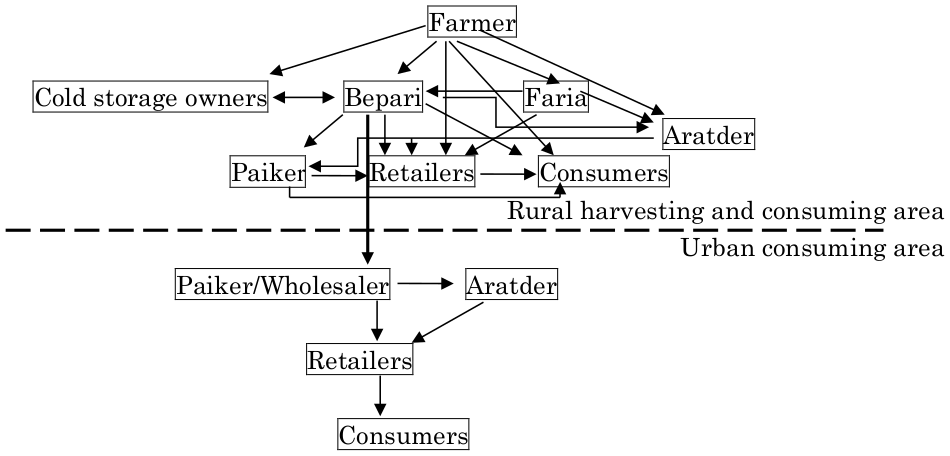
Common marketing channel of potato in Bangladesh. (Modified from Moazzem and Fujita, 2004 and Huq et al., 2004).
In marketing system, marketing margin has been defined as the difference between the price received by the producers and the price paid by the final consumers which is composed of two components, marketing cost and net margin or profit (Huq et al., 2004). In a specific stage of marketing channel, the difference between the purchasing price and the selling price is called the marketing margin of that stage. Investment in the potato market is characterized by high risk and high return. Therefore, high profitability is not unlike in potato marketing due to the involvement of the high price risk (Moazzem and Fujita, 2004). Previously we discussed that the distribution channel of potato in Bangladesh is generally long. The conventional claim is that the middlemen are slicing off a major portion of the consumer’s price as profit (Sarker and Sasaki, 1999a). Contrary to this statement, it was found that the long distribution channel in Bangladesh was economically effective (Sarker and Sasaki, 1999b) due to scarcity of employment. The average farm gate, wholesale and retail price of potato in Bangladeshi is increasing in recent FY than earlier (Fig. 4).
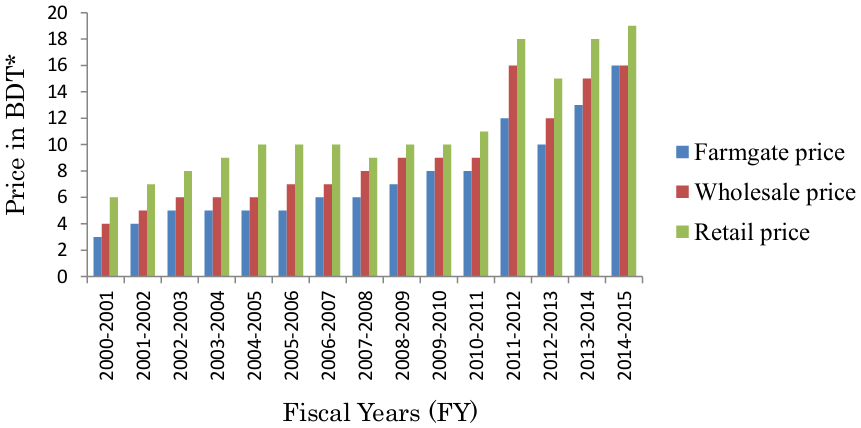
Average farm gate, wholesale and retail prices of potato during FY of 2000-2001 to 2014-2015. Data showed in taka/kg. *BDT= Bangladeshi currency (Taka), 1 BDT= 1.32 JPY= 0.012 $. Source: DAM, 2016.
Seasonal price variation of potato in Bangladesh is very high. During the harvesting period, price becomes very low in contrast to other time. February and March are the harvesting time for potato in Bangladesh. Major portion of potato is harvested during March. So, in March the price becomes very low and sometimes farmers cannot get fair price (Sabur, 1990). We divide our analyzed data in to three groups: 2000-2005, 2006-2010, and 2011-2015 for understanding the price variation in every 5 years (Fig. 5). The price variation is higher in 2011-2015 than other two groups which suggested that the production cost of the recent years increase rapidly.
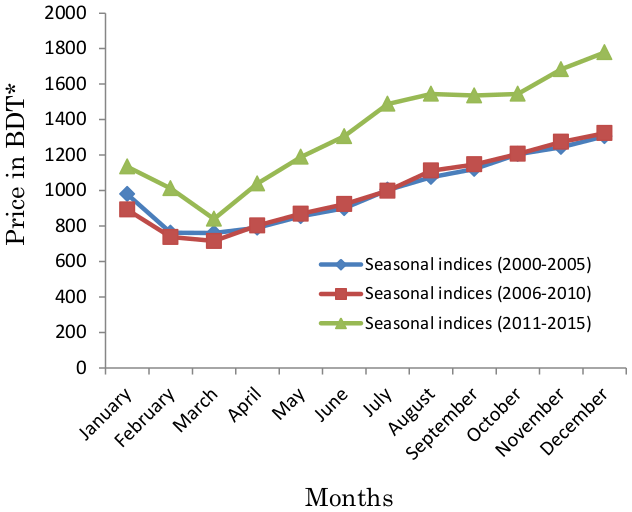
Seasonal fluctuation of potato price in wholesale market. Data showed in taka/quintal. 1 quintal= 100 kg. Source: DAM, 2016; Hajong et al., 2014.
The tuber crops research center of Bangladesh Agricultural Research Institute has already released 66 high yielding variety of potato (Roy et al., 2017) which also responsible for the huge production of potatoes in Bangladesh. Bangladesh produces more potato than its demand. So, Bangladesh exports potatoes to other countries from few years ago (Fig. 6). Now, Bangladesh exports potato and potato oriented items to different countries like as United Arab Emirates, Belgium, Brunei, Bahrain, Canada, Netherlands, Russia, and Singapore and so on (BEPB, 2016). In recent years Japan also import potato from Bangladesh. Bangladesh earned 33822638.25 USD $ during the FY of 2013-14. Though the exports decreased in the FY of 2014-15 and 2015-16 but we hope the export will increase from the next FY. Due to the excess amount of potato production 9.2 million metric tons against the demand of 7.0 million metric tons in recent years; Bangladesh is capable to export a considerable amount of good quality surplus potato to other countries (BBS, 2016).
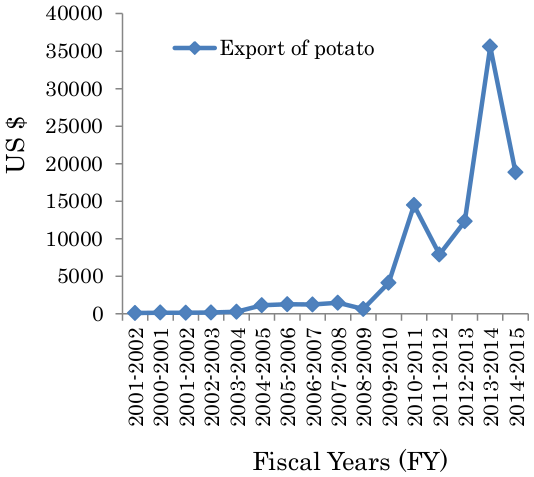
Scenario of potato export in USD $ during the FY of 2000-2001 to 2014-2015. Source: BEPB, 2016; FAOSTAT, 2019.
Bangladesh is a densely populated country. To ensure the food security of the all people of Bangladesh, the Government of Bangladesh tries to promote to change the food habit of people and influence them to eat more potato than rice because the nutrition value is more or less similar. To use as a staple food in Bangladesh, Department of Agricultural Marketing took some innovative strategy and also give some different types of recipes which can easily made from potatoes.
To eradicate malnutrition and hunger from developing countries, potato plays a vital role after rice, wheat and maize (Swaminathan, 2001; Arun et al., 2015) but produces more food/hector/day than wheat, rice and maize (Kumar and Pandey, 2008). In addition, due to the increasing population pressure, growing urbanization and rapid changes of consumers demand and market preferences, sustainable changes in potato consumption in developing countries has been identified (Pandey et al., 2005). These things trigger to increase production of potato which makes Bangladesh one of the potatoes producing leading country in the world. In Bangladesh, land quality, availability of quality high yielding varieties seed and government policy also helpful to increase the total potato production in future. So, export of potato and potato oriented industry will also increase in Bangladesh which will help to generate new employment to the people. In addition, it is evident that to increase the farmers share from the marketing system, co-operative marketing system will be a good solution (Pandey et al., 2005). To increase the potato cultivation for increased production, government can introduce co-operative marketing system among rural farmers to maintain the sustainable production. To develop more sufficient flow of potatoes in the market, more research is needed. Research institutes can take initiatives to develop overall situation of potato.
The potato production of Bangladesh is confirmed as advantageous, sustainable and profitable. There is potential to improve the performances of potato through identifying the opportunities to leverage the development of potato sectors. Cultivation of potato and post-harvest operations establish an important source of employment and income in developing countries. In Bangladesh where land is limited with a huge labor force, potato is ideally suitable to grow. However some major problems such as, poor transportation system, price uncertainty, inefficient marketing system, poor communication, lack of capital, high cold storage charges and so on affect both the growers and the consumers. So, it is very much important to take necessary steps by Government and related associations to ensure the flow of good solution from potato’s cultivation to marketing. Market demand of potato is high and increasing. To hold this situation and remain potato in second leading main crops to meet the demands of increasing populations, it is needed to develop the all potato associated sectors in Bangladesh.